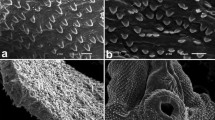Abstract
Emergence of drug-resistant Fasciola strains has drawn the attention of many authors to alternative drugs. The purpose of this study is to explore the in vitro effect of the antimalarial mefloquine against adult Fasciola gigantica. Light and scanning electron microscopic observations could be used to determine the target of the drug following 6 and 12 h of incubation in medium containing mefloquine at three different concentrations 10, 20 and 30 μg/mL, as morphological changes could be observed. These changes occurred in definite sequences in response to mefloquine, and were consisted of swelling, vacuolization that was later disrupted, leading to desquamation of the tegument, resulting in exposure and disruption of basal lamina and the dislodging of spines. It is concluded that mefloquine presented itself as a drug that might become important in trematode chemotherapy, with the tegument being an important drug target.



Similar content being viewed by others
References
Alvarez-Sanchez MA, Mainar-Jaime RC, Perez-Garcia J, Rojo-Vazquez FA (2006) Resistance of Fasciola hepatica to triclabendazole and albendazole in sheep in Spain. Vet Rec 159:424–425
Apinhasamit W, Sobhon P (1996) Opisthorchis viverrini: effect of praziquantel on the adult tegument. Southeast Asian J Trop Med Public Health 27:304–311
Bancroft JD, Stevens A, Turner DR (1996) Theory and practice of histological techniques, 4th edn. Churchill Livingstone, New York
Devinea C, Brennana GP, Lanusseb CE, Alvarezb LI, Trudgetta A, Hoeya E, Fairweathera I (2012) Potentiation of triclabendazole action in vivo against a triclabendazole-resistant isolate of Fasciola hepatica following its co-administration with the metabolic inhibitor, ketoconazole. Vet Parasitol 184:37–47
Fairweather I, Boray JC (1999) Fasciolicides: efficacy, actions, resistance and its management. Vet J 158:81–112
Halferty L, Brennan GP, Trudgett A, Hoey L, Fairweather I (2009) Relative activity of triclabendazole metabolites against the liver fluke, Fasciola hepatica. Vet Parasitol 159:126–138
Holtfreter MC, Loebermann M, Klammt S, Sombetzki M, Bodammer P, Riebold D, Kinzelbach R, Reisinger EC (2011) Schistosoma mansoni: schistosomicidal effect of mefloquine and primaquine in vitro. Exp Parasitol 127:270–276
Ibarra OF, Jenkins DC (1984) An in vitro screen for new fasciolicidal agents. Z Parasitenkd 70:655–661
Keiser J, Morson G (2008) Fasciola hepatica: surface tegumental responses to in vitro and in vivo treatment with the experimental fasciolicide OZ 78. Exp Parasitol 119:87–93
Keiser J, Utzinger J (2005) Emerging food borne trematodiasis. Emerg Infect Dis 11:1507–1514
Keiser J, Engels D, Büscher G, Utzinger J (2005) Triclabendazole for the treatment of fascioliasis and paragonimiasis. Expert Opin Investig Drugs 14:1513–1526
Keiser J, Shu-Hua X, Tanner M, Utzinger J (2006) Artesunate and artemether are effective fasciolicides in the rat model and in vitro. J Antimicrob Chemother 57:1139–1145
Keiser J, Odermatt P, Tesana S (2009) Dose-response relationships and tegumental surface alterations in Opisthorchis viverrini following treatment with mefloquine in vivo and in vitro. Parasitol Res 105:261–266
Khan MK, Sajid MS, Khan MN, Iqbal Z, Iqbal MU (2009) Bovine fasciolosis: prevalence, effects of treatment on productivity and cost benefit analysis in five districts of Punjab, Pakistan. Res Vet Sci 87:70–75
Manneck T, Haggenmüller Y, Keiser J (2010) Morphological effects and tegumental alterations induced by mefloquine on schistosomula and adult flukes of Schistosoma mansoni. Parasitology 137:85–98
Manneck T, Braissant O, Ellis W, Keiser J (2011) Schistosoma mansoni: antischistosomal activity of the four optical isomers and the two racemates of mefloquine on schistosomula and adult worms in vitro and in vivo. Exp Parasitol 127:260–269
McKinstry B, Fairweather I, Brennan GP, Forbes AB (2003) Fasciola hepatica: tegumental surface alterations following treatment in vivo and in vitro with nitroxynil (Trodax). Parasitol Res 91:251–263
McManus DP, Dalton JP (2006) Vaccines against the zoonotic trematodes Schistosoma japonicum, Fasciola hepatica and Fasciola gigantica. Parasitology 133(Suppl):S43–S61
Meaney M, Fairweather I, Brennan GP, Ramasamy P, Subramanian PB (2002) Fasciola gigantica: tegumental surface alterations following treatment in vitro with the sulphoxide metabolite of triclabendazole. Parasitol Res 88:315–325
Overend DJ, Bower FL (1995) Resistance of Fasciola hepatica to triclabendazole. Aust Vet J 72:275–276
Schweizer G, Braun U, Deplazes P, Torgerson PR (2005) Estimating the financial losses due to bovine fasciolosis in Switzerland. Vet Rec 157:188–193
Shalaby HA, El Namaky AH, Kamel ROA (2009) In vitro effect of artemether and triclabendazole on adult Fasciola gigantica. Vet Parasitol 160:76–82
Van Nassauw L, Toovey S, Op V, den Bosch J, Timmermans JP, Vercruysse J (2008) Schistosomicidal activity of the antimalarial drug, mefloquine, in Schistosoma mansoni-infected mice. Travel Med Infect Dis 6:253–258
Xiao SH, Bingguri S, Utzinger J, Chollet J, Tanner M (2002) Transmission electron microscopic observations on ultrastructural damage in juvenile Schistosoma mansoni caused by artemether. Acta Trop 81:53–61
Xiao S, Collet J, Utzinger J, Mei J, Jiao P, Keiser J, Tanner M (2009a) Effect of single-dose oral mefloquine on the morphology of adult Schistosoma japonicum in mice. Parasitol Res 105:853–861
Xiao S, Mei J, Jiao P (2009b) The in vitro effect of mefloquine and praziquantel against juvenile and adult Schistosoma japonicum. Parasitol Res 106:237–246
Xiao S, Xue J, Shen B (2010) Transmission electron microscopic observation on ultrastructural alterations in Schistosoma japonicum caused by mefloquine. Parasitol Res 106:1179–1187
Author information
Authors and Affiliations
Corresponding author
Rights and permissions
About this article
Cite this article
Shalaby, H.A., El Namaky, A.H. & Kamel, R.O.A. In vitro tegumental alterations on adult Fasciola gigantica caused by mefloquine. J Parasit Dis 40, 145–151 (2016). https://doi.org/10.1007/s12639-014-0466-y
Received:
Accepted:
Published:
Issue Date:
DOI: https://doi.org/10.1007/s12639-014-0466-y




